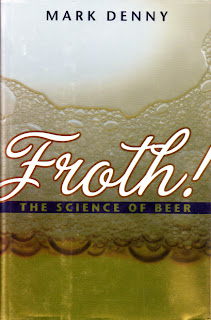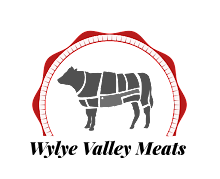Froth!
The Science of Beer
Mark
Denny
2009,
HB, 183pp
The Johns Hopkins University Press
The Johns Hopkins University Press
£13.50
delivered from Amazon
Reviewed
July 2012
Mark
Denny is a homebrewer and a physicist. In the Introduction he sets
out his stall: “My book is unique to the best of my knowledge, in
that it unites brewing with accessible physics.” I imagine that at
this point many of you will move along but I rather like the idea.
After all pretty much everything is physics, even beer. But if
mixing physics with beer isn't for you then it gets worse—there's
mathematics too. (I'm not selling this well, am I?). But panic not,
the maths can be bypassed—that's what I did most of
the time.
Before
getting to the science Denny outlines the history of beer and
brewing. Maybe he should have stuck to the science. This
chapter is riddled with inaccuracies and not-quite-accurate
assertions. Did Balling introduce the hydrometer into brewing in
1843? That must have surprised Baverstock you was using one in 1770.
Is porter really stronger than stout? Is stout usually dry? Guinness
has been so only since the 1950s and London stouts never really were.
This chapter is too long and a rather out of place. This is a book
about “the science of beer”—get to the science! And I hated the
stupid interlude inserted to break the chapter into two.
Next
up is How to Make Good Beer at Home.
Still no science then. This is a very basic introduction to
homebrewing but at the same time idiosyncratic and opinionated.
Certainly not for the homebrewing purists. Denny advocates natural
cooling of wort, plastic bottles etc. Personally I don't have too
much of a problem with that but like the previous chapter this seem a
bit out of place in a book about the science of beer. Who is the book
aimed at? The general reader? The beginner? Or the more advanced
brewer? I would have thought it was the latter in which case a
homebrewing primer is an unnecessary waste of space.
There
are some odd mistakes for a scientist to make like stating that
crystal malt is an adjunct: the clue is in the name, surely—it's a
malt. And using the yeast from bottle conditioned beer: ”Don't
throw away the gunk—feed it with yeast nutrient...and pitch it into
your next brew. It will go like a rocket.” Probably not.
Finally,
nearly halfway through the book we get to the science. The
book gets much better from here.
Yeast
Population Dynamics
Quite
a lots of mathematical formulae from here on but these are explained
and can be skimmed over and the text will still make sense.
This
chapter contains one of the best description I have read of why yeast
pitching rate is important. Clear, concise, and well explained both
mathematically (by formulae) and in the text. The maths can be hard
and is mostly beyond me but the explanations are good.
Brewing
Thermodynamics
Sounds
a laugh-a-minute, doesn't it?. But, of course, temperature control is
a fundamentally important part of brewing so this is relevant stuff.
The chapter covers a whole range of situations such as the heat
produced by yeast during respiration, heating the mash, cooling the
wort, temperature control etc. Lots of good stuff.
Now
it has to be said that the design of the formulae and the associated
explanations is a bit poor. New terms are introduced and the
explanation of what they represent can be hard to find, sometimes
hidden in the text of the next paragraph. Poor book design, in fact.
One
thought provoking fact: enough heat is produced by the fermenting
yeast in a standard wort to boil the whole batch. Lucky that heat is
lost from the fermenter then.
Bubbles
Bubbles
are everywhere in brewing. You might have noticed that. I found this
chapter really stimulating. They is quite a lot of abstruse science,
and I am sure some of it isn't that important, but most of it was
absolutely fascinating. Fermentation is discussed in some detail and
we learn that a typical homebrew fermentation might generate 35
billion bubbles. See what I mean? Not terribly useful but interesting
and dead good for boring the guys down the pub. Denny points out that
(for the US, I think) 0.5% of all
carbon dioxide emissions are produced by beer production.
Beer
froth and head production turn out to be more complex that you might
think. Hey, one paper on the subject received an Ig Nobel Prize. The
head on a beer is a surprisingly complex and dynamic system as Denny
explains. He also discusses the background to the use of
nitrogen/mixed gas and also shows why it isn't terribly beneficial to
beer flavour. He gives a great explanation of how a widget works.
They are surprisingly simple and are, in effect, a type of sparkler.
Mention is made of disproportionation, which is another good
one for use down the pub, and negative bubbles (a spherical layer of
gas with liquid inside and outside of the sphere.
This
chapter is probably the most successful of the book and is full of
fascinating insight and some interesting science.
Fluid
Flow
The
final “science” chapter uses its title rather liberally. Most of
it is taken up with the mathematics of bulk beer distribution which
is, just about, an example of fluid flow. This is the only section
where I found my inability to understand the mathematics frustrating.
It would have been helpful to have had the various formulae more
fully explained and not to have taken so much on faith. Maybe an
appendix for thickos like me could have been added?
A
brief discussion of how beer is moved from cellar to bar and an
appreciation of how complex the action of drinking a beer is in terms
of physiology, completes the chapter.
There
are a few odd assertions—are
electric pumps replacing beer engines on the bars of English pubs?
I'm not sure when I last saw an electric pump. I used to love
watching a diaphragm pump dispensing a pint of Bank's mild when I
were a lad. But then earlier in the book there was the assertion that
the barrel (36 gallon) and the pin (4½ gallon) are the most common
UK cask container size when the firkin (9) and the kilderkin (18)
are, by far, the most common size encountered.
Final
Thoughts
Not
a lot to say about this chapter. Simply a summing up of what went
before.
Throughout
the book some of the graphs are poorly designed and sometimes
inappropriate for the data they depict—line
graphs where bar graphs would have been better, for example, which is
rather odd for a book published by an university
press.
The
very simple brewing technique described is at odds with some of the
science explained, especially in the thermodynamics section.
The
book is a good quality hardcover, nicely printed, with a sown
binding. In fact the cover is so substantial, for the size of book,
that it may constitute a dangerous item. Don't try and take it onto
an airplane.
Froth!
is a brave attempt at a different homebrewing book. It contains some
thought provoking information and certainly encourages the reader to
look at things from a different perspective. But it is not a great
book. Nearly half the book is not, in fact about “the science of
beer”. Most of the beery science is interesting, some of it thought
provoking, and some of it might even improve your brewing. Although
the text is designed so that the mathematics can be missed out it is
a pity that some space could not have been found to more fully
explain how the formulae are derived. The mathematics is the backbone
of several sections and not being able to understand it is very
frustrating.
Froth!
is not a book for everyone and newby brewers should avoid it if
they don't want their head to explode. The more advanced and/or
technical brewer will certainly get something from the book and it
encourages the assessment of the brewing process from a new
perspective.
So
recommended (but with significant reservations) especially at £13.50 for a “proper”
hardback.










